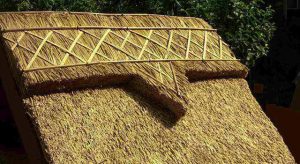The ridge of a thatched roof bears the brunt of the weather and, as the fixings are external, it requires attention on average every 10 to 15 years. The material used is usually the same as that used for the main coatwork, however, water reed is too stiff and brittle. As a result, the ridge of a water reed roof is often made with sedge.
 The patterned ridges which have become popular allow the thatcher some artistic licence, but they are a relatively new innovation and as such are thought to be unsuitable for the majority of historic thatched properties. Different considerations apply in the re-thatching of an old building and one of recent date and it is probably fair to say that a house built prior to the 19th Century requires good plain workmanship without too much embellishment.
The patterned ridges which have become popular allow the thatcher some artistic licence, but they are a relatively new innovation and as such are thought to be unsuitable for the majority of historic thatched properties. Different considerations apply in the re-thatching of an old building and one of recent date and it is probably fair to say that a house built prior to the 19th Century requires good plain workmanship without too much embellishment.
There are two main types of ridge – the ‘wrap-over’ which is used most widely, and the ‘butt-up’ which is found mainly in the south-west of the country where its use would appear to have developed from the stiffer nature of combed wheat reed. The ‘butt-up’ ridge has the butts of the material forced together from either side to form an apex whereas the ‘wrap-over’ is formed by folding a thick layer of material over the apex of the roof and fixing it on both sides.
